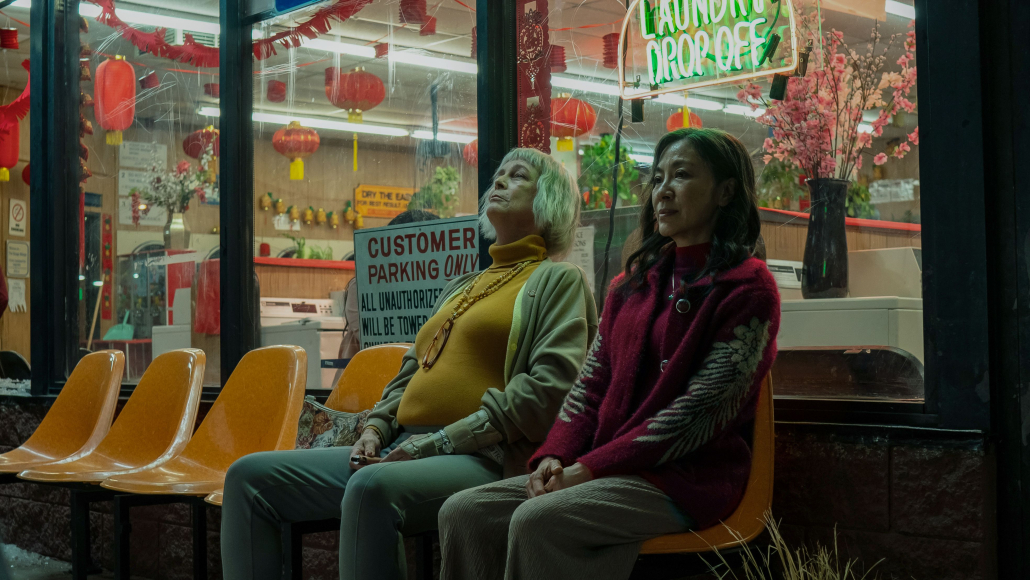‘Everything Everywhere All at Once’ is mesmerizing

This review contains spoilers.
There’s a powerfully thrilling quality to “Everything Everywhere All at Once,” a film with so many seemingly separate things within itself that somehow manages to make meaning out of all of them. Directed by Daniels (Daniel Kwan and Daniel Scheinert), “Everything Everywhere All at Once” reinforces the emotional qualities of an immigrant drama narrative with nuances to sci-fi and action genres. This combination might seem odd, but it ends up working out, benefiting the movie and its storyline.
Michelle Yeoh stars as protagonist Evelyn Wang, a middle-aged Chinese woman struggling financially and emotionally. The film opens with Evelyn running a laundromat which the IRS is auditing. Evelyn’s daughter Joy (Stephanie Hsu) is angry with her mother for never accepting her queerness and place in life. Then, just as Evelyn attempts to deal with her taxes, Evelyn’s husband Waymond (Ke Huy Quan) reveals he wants a divorce. All of this stress piles onto Evelyn, and eventually, she’s not only caught up in multiple issues but also multiple universes.
The logistics of the whole switching between many universes component are a bit confusing and complicated to understand. Audiences might end up just as bewildered as Evelyn when her “husband” from another universe appears in her current husband’s body before a tax audit. This rapid transformation involves Waymond suddenly assuming a confident and commanding demeanor, one much unlike the meek Waymond that Evelyn knows. Also, one thing to note: This Waymond apparently doesn’t need glasses.
During this abrupt transition in an elevator, this version of Waymond tells Evelyn that she must save the multiverse from an existential threat — an individual named Jobu Tupaki who wants to absorb the world into nothingness — by transporting herself to other universes. Within these universes are Evelyn’s alternate selves, each one of which possesses different skillsets (e.g. Kung Fu) that can help Evelyn defeat her enemies, minions of Jobu Tupaki.
Waymond informs Evelyn that individuals can “jump” to their other selves by establishing pathways, which are oddly specific actions such as eating a stick of ChapStick. Performing these actions can then stimulate the jump between universes.
Although this idea might seem cliché, the film invites audiences to consider all the different lives we might have led had we taken a different path or made a different decision. As viewers follow Evelyn as she exists as diverse versions of herself, we’re shown the seemingly unlimited range of possibilities that could have determined Evelyn’s identity. Each one appears to have more potential for life than the present Evelyn. All of these sequences are delightfully bizarre and bizarrely delightful.
In one, Evelyn is a celebrity actress. In another, she’s a martial artist — a skillset that comes in handy during the excellently choreographed action scenes. One of the most hilarious universes features Evelyn as a teppanyaki chef and Harry Shum Jr. as a fellow chef whose prolific cooking skills are controlled by a raccoon — an intelligently orchestrated nod to the animated film “Ratatouille.”
Afterward it’s revealed that Jobu Tupaki is, in fact, a version of Evelyn’s daughter Joy. It’s implied that Joy’s villainous alter ego is brought about by her mother’s nonacceptance and the emotional and psychological turmoil that resulted from it. The notion of this, which caused her “fractured” mind in the multiverse, is an engaging metaphor that doesn’t try to tell the audience that it’s significant but, rather, attempts to show through the complicated mother-daughter relationship seen throughout all these different universes.
Even as Evelyn and Joy change forms and fight epic battles that wouldn’t have been possible in the current universe, there’s always a deeply empathetic quality to their intergenerational interactions. Thus, “Everything Everywhere All at Once” really does make a statement on everything, even if it’s in a haphazard way. Yet, paradoxically, the film’s haphazardness is what makes the execution of the story genius.
The film beautifully captures the generational trauma experienced by an immigrant family from China to the United States, used as a jumping off point to make a statement about Chinese diasporic identity: What it means to be a child of immigrants. Then, it illustrates, an incredibly imaginative sci-fi take on dreaming, beyond one’s own mediocrity.
Given that Yeoh is one of the top actresses in Hollywood right now, it’s almost startling seeing her character labeled as a failure. Yet, despite the role’s many contradictions, Yeoh brings out the struggles of Evelyn’s inner self in a sensitive, three-dimensional way.
Watching her, one doesn’t look at Evelyn and think, “Oh, it’s Michelle Yeoh.” Instead, we see a Chinese immigrant woman who’s trying to do her best: One who didn’t quite manage to achieve her dreams in life but has the potential to make the life she’s living a better one.
“Everything Everywhere All at Once” is quirky and unexpected, a whole multiverse that reaches far into the depths of humanity to consider how we make meaning of ourselves. The process of traversing worlds also teaches us which ones we should value. After all, while there are so many universes in the world, it’s this one that we’re living in at the end of the day.
Rating: 5/5

